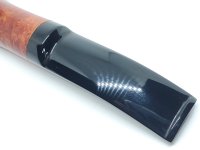The best of what's made today is as good as the historical best.
The issue isn't composition in the recipe sense as much as care and quality control, which boils down (mostly) to inclusions. Or, more precisely, a
lack of them.
A while back Japanese rubber was notorious for inclusions. Something got into the mixer that later oxidized and "bloomed" into visible specks:
View attachment 241031
I've avoided it ever since.
(Little doubt they found and fixed the problem in current production, but since vulcanite rods have no shelf life, and the "bloom" happens AFTER a stem is cut and a fresh surface exposed to air and light, there's no way to know if what's on supplier shelves today belongs to the "bad batch era".)
SEM I've found to usually be OK, but frequently turns weirdly dull and cloudy a year or so after being cut. Not oxidation, but something else. Not sure what's going on there.
NYH is the only brand that has been problem free both at stem-cut time and in the years afterward, in my experience.













